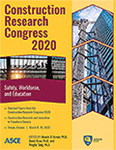Construction Research Congress 2020
Towards Point Cloud and Model-Based Urban Façade Inspection: Challenges in the Urban Façade Inspection Process
Publication: Construction Research Congress 2020: Safety, Workforce, and Education
ABSTRACT
In a densely populated city like New York City (NYC), more than 14 thousand buildings are mandated for the façade safety inspection program to ensure public safety. Current inspection process relies on visual inspection by certified inspectors. Photos and sketches are adopted to document the findings during each inspection. Existing construction code from city departments provides the general information of a façade safety program, while a generic checklist that an inspector can follow for each exterior enclosure type is missing. The existing way of capturing building data and defects are ineffective for understanding and not sufficient to provide a holistic view of the façade condition for the review process. This paper provides details and results of three shadowing works conducted with façade inspectors to capture the workflow that façade inspectors follow on different exterior enclosure types. The shadowing results were analyzed to examine the information inspectors collect during the inspection for each component and defect type. Initial findings, presented in this paper, provide evidence for the need for streamlining the existing façade inspection process with an approach that could guide the data collection and decision-making and enable the collection and identification of such information completely and accurately.
Get full access to this article
View all available purchase options and get full access to this chapter.
REFERENCES
Anil, E. (2015). “Utilization of as-is building information models obtained from laser scan data for evaluation of earthquake damaged reinforced concrete buildings.”
City of Columbus. (2019). “Critical observation form.” Retrieved from https://www.columbus.gov/search.aspx?q=critical%20observation%20form
City of Pittsburgh. (2019). “Façade inspections.” Retrieved from https://pittsburghpa.gov/pli/pli-facade-inspections
Eschmann, C., Kuo, C.-M., Kuo, C.-H., Boller, C. (2012). “Unmanned aircraft systems for remote building inspection and monitoring.” Proc., the 6thEuropean Workshop on Structural Health Monitoring, German Society for Nondestructive Testing, Germany.
Galarreta, J.F., Kerle, N., and Gerke, M. (2015). “UAV-based urban structural damage assessment using object-based image analysis and semantic reasoning.” Natural Hazards and Earth System Sciences, 15, 1087-1101.
Jahanshahi, M.R., Masri, S. F., Padgett, C. W., and Sukhatme, G. S. (2013). “An innovative methodology for detection and quantification of cracks through incorporation of depth perception.” Machine Vision and Applications, 24 (2), 227-241.
Kasireddy, V., and Akinci, B. (2015). “Challenges in generation of as-is bridge information model: a case study.” Proc., 2015 Proceedings of the 32nd ISARC, Oulu, Finland.
Kim, M., Sohn, H., and Chang, C. (2014). “Localization and quantification of concrete spalling defects using terrestrial laser scanning.” Journal of Computing in Civil Engineering, 29 (6).
Laefer, D.F., Gannon, J., and Deely, E. (2010). “Reliability of crack detection methods for baseline condition assessments.” Journal of Infrastructure Systems, 16 (2), 129-137.
Lattanzi, D. and Miller, G. R. (2014). “3D scene reconstruction for robotic bridge inspection.” Journal of Infrastructure Systems, 21(2).
Mader, D., Blaskow, R., Westfield, P., and Weller, C. (2016). “Potential of UVA-based laser scanner and multispectral camera data in building inspection.” Proc. International Society for Photogrammetry and Remote Sensing, ISPRS Congress, Czech Republic, 1135-1142.
Mukupa, W., Roberts, G. W., Hancock, C. M., and Al-Manasir, K. (2016). “A review of the use of terrestrial laser scanning application for change detection and deformation monitoring of structures.” Survey Review, 49 (353), 99-116.
Ida, Siegal. (2019) “Car crashed as bricks from façade collapse rain down in NYC.” Retrieved from https://www.nbcnewyork.com/news/local/Facade-Collapse-Bricks-Crush-Cars-Bronx-507450221.html
NYC DOB. (2019). “Façade safety report.” Retrieved from https://www1.nyc.gov/site/buildings/about/facade-safety-report.page
Omari, S., Gohl, P., Burri, M., Achtelik, M., and Siegwart, R. (2014). “Visual industrial inspection using aerial robots.” Proc., the 2014 3rdInternational Conference on Applied Robotics for the Power Industry, IEEE, Brazil, 1-5.
Prasanna, P., Dana, K. J., Gucunski, N., Basily, B. B., La, H. M., Lim, R. S., and Parvardeh, H. (2016). “Automated crack detection on concrete bridges.” IEEE Transportations on Automation Science and Engineering, 13 (2), 591-599.
Roca, D., Laguela, S., Diaz-Vilarino, L., Armesto, J., and Arias, J. (2013). “Low-cost aerial unit for outdoor inspection of building façades.” Automation in Construction, 36, 128-135.
Silvestre, J.D., and de Brito, J. (2011). “Ceramic tiling in building façades: Inspection and pathological characterization using an expert system.” Construction and Building Materials, 25 (4), 1560-1571.
Son, H., Bosche, F., and Kim, C. (2015). “As-built data acquisition and its use in production monitoring and automated layout of civil infrastructure: A survey.” Advanced Engineering Informatics, 29 (2), 172-183.
Matt, Rocheleau. (2019). “Building façade collapses are not unusual.” Retrieved from https://www.bostonglobe.com/metro/2018/11/16/was-allston-facade-collapse-freak-accident-maybe-not/IweuDFpRoOtBm2FOJRmJfN/story.html
Wiss, Janney, Elstner Associates, Inc. (2019). “Façade ordinances.” Retrieved from http://www.facadeordinance.com/
Yu, Y., Li, J., Guan, H., and Wang, C. (2014). “3D crack skeleton extraction from mobile LiDAR point clouds.” Proc., 2014 IEEE Geoscience and Remote Sensing Symposium, IEEE, Quebec City, Canada, 914-917.
Zhang, W., Zhang, Z., Qi, D., and Liu, Y. (2014). “Automatic crack detection and classification method for subway tunnel safety monitoring.” Sensors, 2014 (14), 19307-19328.
Zhong, X., Peng, X., Yan, S., Shen, M., and Zhai, Y. (2018). “Assessment of the feasibility of detecting concrete cracks in images acquired by unmanned aerial vehicles.” Automation in Construction, 89, 49-57.
Zhou, Z., Gong, J., and Guo, M. (2015). “Image-based 3D reconstruction for posthurrican residential building damage assessment.” Journal of Computing in Civil Engineering, 30 (2).
Information & Authors
Information
Published In
Construction Research Congress 2020: Safety, Workforce, and Education
Pages: 385 - 394
Editors: Mounir El Asmar, Ph.D., Arizona State University, David Grau, Ph.D., Arizona State University, and Pingbo Tang, Ph.D., Arizona State University
ISBN (Online): 978-0-7844-8287-2
Copyright
© 2020 American Society of Civil Engineers.
History
Published online: Nov 9, 2020
Published in print: Nov 9, 2020
Authors
Metrics & Citations
Metrics
Citations
Download citation
If you have the appropriate software installed, you can download article citation data to the citation manager of your choice. Simply select your manager software from the list below and click Download.
